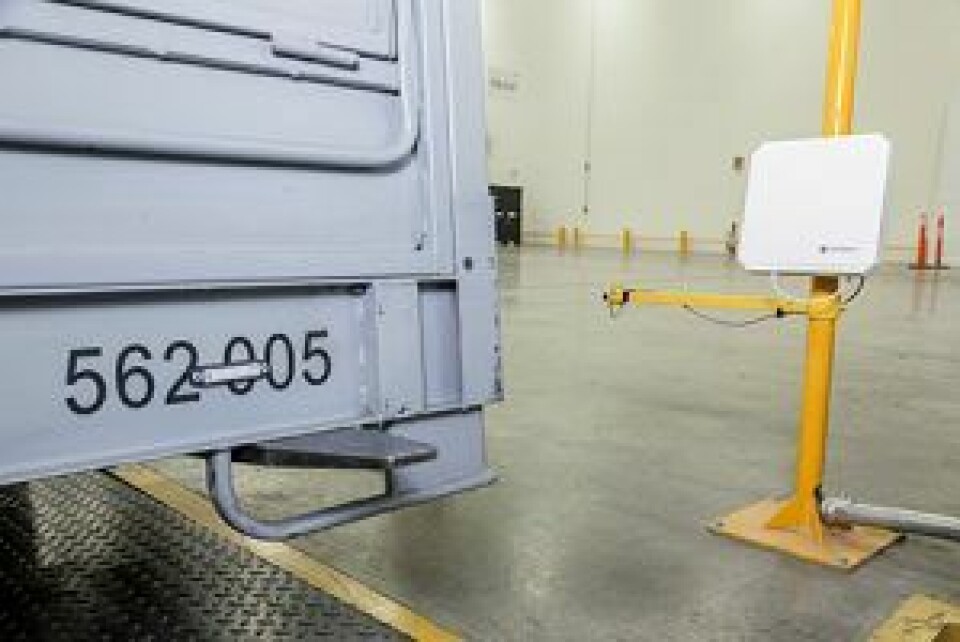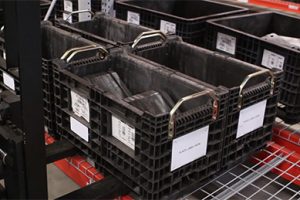Smart packaging: The quest for greater precision
![]() Packaging is one area in the automotive supply chain in which greater connectivity and ‘internet of things’ (IoT) devices have the potential to make significant improvements. Many of the chronic issues that accompany the management and flow of equipment, including missing or incorrect containers, damage to parts, as well as manual scanning and processing, could possibly benefit from further development in the area.
Packaging is one area in the automotive supply chain in which greater connectivity and ‘internet of things’ (IoT) devices have the potential to make significant improvements. Many of the chronic issues that accompany the management and flow of equipment, including missing or incorrect containers, damage to parts, as well as manual scanning and processing, could possibly benefit from further development in the area.
Indeed, such technology is not just in the future. Carmakers and tier suppliers are already using a range of tools, including RFID, GPS (satellite tracking), GSM (mobile phone sim cards), wi-fi and environmental sensors, all of which offer new ways to track and monitor packaging.
[in_this_story align="right" border="yes"]For example, at its new plant in San José Chiapa, Mexico, Audi is already using its own RFID technology system to monitor parts; it is even now beginning to extend this packaging approach to suppliers. Elsewhere, suppliers such as Magna are exploring the potential of using Bluetooth-enabled packaging.
However, the implementation of such ‘smart packaging’ reveals that the devil is often in the detail. While reading tags and sensors might be effective in closed environments, like plants and warehouses, things get more difficult during transport – and also much more expensive. Meanwhile, without fully automated reader systems, tagged equipment may well require a lot of manual scanning, in part defeating the point of such technology. Also, the costs of backup systems can undo savings elsewhere.
Still, there is little question that the potential for improving packaging visibility and processes through better connectivity is high, and that interest is increasing among automotive manufacturers.
Packaging’s more strategic roleAs supply chains move increasingly towards individual item tracking, packaging is beginning to take on a critical role in providing the data required.
OEMs are now working with packaging solution providers on advanced systems that offer real-time information on a box’s location, contents and condition. But although new technology is removing (or at least reducing) the guesswork, not everyone is looking for the same attributes in their ‘smart’ packaging.
The term ‘smart packaging’ certainly means different things to different people, including which kind of sensors or systems are best to use. Up to now, carmakers have been relatively cautious in the technology they use to track packaging. At Wisconsin-based packaging provider Orbis, industrial marketing manager Scott Krebs suggests that smart packaging is currently useful among carmakers for ‘discreet’ asset tracking.
“For the automotive sector, smart packaging has been about high-level tracking on trucks or of specific products if there is a problem with the supplier,” he says, adding that it is particularly useful for tracking high-value parts.
 "For the automotive sector, smart packaging has been about high-level tracking on trucks or of specific products if there is a problem with the supplier [but this focus is shifting]." - Scott Krebs, Orbis
"For the automotive sector, smart packaging has been about high-level tracking on trucks or of specific products if there is a problem with the supplier [but this focus is shifting]." - Scott Krebs, Orbis
However, Krebs suggests there will be a move away from smart packaging that communicates only on an exception basis – for example, when a particular temperature or location threshold is breached – to more routine communication, such as a ping every 15 minutes, allowing a more analytics-based management approach.
While things aren’t at that stage yet, he admits, companies are realising that there is a lot of value to be gained with the use of data analytics, including lower inventory and cash expenses.
Michael Wappler, vice-president of global client solutions at Ohio-based packaging solutions provider Surgere, says technologies such as passive and active RFID, near-field communications (Bluetooth) and GPS, in particular, are helping to add such granular, reliable data and thereby playing a more proactive role in improving visibility and avoiding critical issues in the automotive supply chain.
Wappler says shippers are no longer satisfied just to gather basic information from the packaging or to determine whether a particular box is still in a particular facility – they now want to follow a package’s complete journey, and with it track movements throughout the entire inbound and outbound supply chain.
One of Surgere’s carmaker clients, for example, wants to observe packaging being filled at the supplier facility, then watch the bill of materials (BOM) lifecycle continue through the trailer’s movement, including pinpointing the trailer in the yard, watching the trailer as it is unloaded, verifying the BOM as it enters the OEM facility, [sta_anchor id="1"]following the flow of the parts through the facility, and even tracking the finished vehicle.
Take-up of smart packaging is in a near-vertical growth curve and a number of companies are currently working with Surgere to install equipment, adds Wappler. “We are in various stages of deployment with OEMs and tier suppliers, and have several information ecosystems under construction,” he confirms.
Audi Mexico’s RFID project shows how ‘smart’ packaging is moving towards more real-time communication

Audi Mexico: tag, you’re itSome OEMs are ahead of others when it comes to using smart packaging in their operations and systems. At Audi, the move to use RFID follows implementation of a new packaging pool for its San José Chiapa plant, which started production in 2016, as well as collaboration with Volkswagen Group’s logistics team in Germany, which manages the group’s common load carrier and bespoke packaging fleet in Europe.
The main priority for Audi Mexico, says Peter Koltai, director of production control and logistics, was to establish a system for determining container location – in particular to find out where each container was and whether it had been sent to a supplier, from one Audi Mexico building to another, or to the repair service. Audi also wanted the option of incorporating further functions in the future, he says.
As a result, Audi Mexico decided to use passive writable RFID tags in combination with Volkswagen Group software to manage container transport.
“The first step is to read labels at various points, which helps us to maintain our inventory,” he says. “The second step is to work with our tier supplier so that it can write to the RFID tags. This saves on operational material costs and labelling labour. It could also increase the speed of goods in operation and save Audi Mexico on broader operational costs.”
Most of Audi Mexico’s packaging is made of plastic, though there is also some steel. There are challenges with both in terms of tag placement, which can affect a fixed scanner’s ability to detect them, says Koltai. “We try to place the tag in the best spot in order to enhance reading capacity and thus the speed to handle data. We also need an alarm in case the system does not read the tags properly,” he explains.
While Audi can read nearly all of the packages, it’s not 100% reliable yet, he admits. “The problem occurs mainly in the receiving area,” he says. “Hidden tags are a major challenge. But if we try to increase the reading energy of an RFID portal, it can read other tags outside the area we want.”
Determining the strength of the reading antenna and just how to set up reading equipment involves a lot of trial and error, says Koltai. And there are further issues about just how containers are layered on a pallet, too. “Even knowing about these factors, we do not know all of the reasons for not reading [some] RFID tags,” he reveals.
[mpu_ad]Audi Mexico is trying to resolve this problem with different suppliers, but in the meantime, it has provided staff in the receiving area with handheld scanners as a backup.
None of its tier one suppliers are using RFID technology themselves, adds Koltai – all the RFID-enabled packaging is Audi’s – and so far the system is only being used on returnable containers and metal pallets from Mexico and a few US suppliers.
In the second phase, the carmaker intends to focus on suppliers’ abilities to write to its tags and wants to begin with a provider that delivers more than once a day, using Audi Mexico’s pooled containers. The idea is to convince the supplier to use the same technology as the OEM, improving logistics efficiency by ensuring smoother data flow.
For now, the process is somewhat more involved, Koltai admits. “Currently, for our inbound parts, all packages must first be taken off the truck. Then, we look at the loading list and do a physical count, and check whether the label from the supplier is completed, or else reprint it,” he says.
[sta_anchor id="2"]“With the smart packaging system, by contrast, the RFID technology would read all the data when unloading the truck and would compare the receipt to the order. If there were to be a failure in reading, then the item in question would stay in the receiving area. This would save half the time in the receiving area, which would otherwise be used for manually checking items,” adds Koltai.
Reading in a controlled spaceTier one supplier Magna International is also using RFID technology, however currently only for in-plant “closed loops”, according to Bridget Grewal, director of packaging continuous improvement. For example, it uses RFID on fascia parts as they move through the plant, as well as for racks.
 Shippers now want to follow a package’s complete journey throughout the entire inbound and outbound supply chain
Shippers now want to follow a package’s complete journey throughout the entire inbound and outbound supply chainSuch in-plant flows are, currently at least, more common for RFID or other sensor-tagged packaging, owing to the benefits of working in a controlled environment, as well as in maintaining accuracy. At Surgere, Wappler says his company has worked on a number of successful implementations.
“We have experienced successful cases for in-plant parts inventory and cycle counting activity, inventory transition monitoring – whether it’s movement or usage – and more importantly the integration of the data into MRP and ERP [manufacturing resource and enterprise resource planning systems],” he says.
In such cases, Surgere uses tags that can be read in real time, allowing changes in information (for example on goods quantity and location) for both human readers and presentation to other IT systems.
“The use of sensor-based technology has also matured; deployment in very large, highly dense, dynamic environments is a reasonable approach to gaining insight and visibility over the existence of smart packaging and parts in a space, [sta_anchor id="3"]how and when they move, when they are changing attributes in response to manufacturing adjustments, and what it all means,” he comments.
“We work with one OEM that is finally using real data to better pinpoint map locations for optimising and dynamically configuring flexible warehouse space, measuring dwell time, locating parts faster, managing movement and reducing inventory – all controlled through intelligent software,” he adds.
Bluetooth potential Moving outside the plant, however, can pose more problems in using technology like RFID or GPS. Magna has had issues when it comes to using RFID on other packaging in transport loops. “For example, our customer and supplier, Adient, had an inventory of $1.2m in RFID tags,” Grewal explains. “It also lost the same amount in containers. The containers were sent to Magna but did not get back to Adient.”
Part of the problem, she says, was that Magna had no suitable RFID-reading equipment at the time and had to bring in some handheld scanners (just as Audi Mexico uses for backup). “Once the containers left the reading area, we could not determine where they were unless we used a handheld scanner,” she says.
Even then, Grewal admits, using handheld devices to locate containers is a challenge. Magna still loses containers and needs to pay for corrugated board boxes as a backup. Currently, some Magna plants carry out manual counting of inventory. Grewal says that the next step would be to use electronic equipment.
 "The first step is to read labels at various points, which helps us to maintain our inventory. The second step is to work with our tier supplier so that it can write to the RFID tags. This saves on operational material costs and labelling labour. It could also increase the speed of goods in operation and save Audi Mexico on broader operational costs." - Peter Koltai, Audi Mexico
"The first step is to read labels at various points, which helps us to maintain our inventory. The second step is to work with our tier supplier so that it can write to the RFID tags. This saves on operational material costs and labelling labour. It could also increase the speed of goods in operation and save Audi Mexico on broader operational costs." - Peter Koltai, Audi Mexico
It has since begun working with Toronto-based solutions provider BeWhere, which provides a system based on gateways around the plant and a beacon on the package or container, which communicates automatically via low-energy Bluetooth. However, the economics of this are not suitable for every application. “The issue is that we cannot put an $8 beacon on a $3 container,” says Grewal. “However, we can put it on bulk containers, racks and pallets, instead of individual containers, making the cost [per item tracked] much lower.”
[sta_anchor id="4"]BeWhere’s beacons and gateways can communicate at ranges of up to 250 metres. The beacons also feature monitoring for temperature and ‘g-force exception’ – significant and potentially dangerous movements and accelerations. Brian Boychuk, senior vice-president of sales and marketing at the company, says the potential of smart packaging will increase by combining Bluetooth asset tracking with IoT devices like thermostats or wi-fi routers.
[related_topics align="right" border="yes"]Measuring from far awayThe potential for ‘condition monitoring’ of parts and packaging in transit and across multiple locations could be the next great step in smart packaging development. Currently, however, high costs and uncertain results appear to be holding back widespread application of such technology.
Audi, for example, has trialled condition monitoring for its packaging. In Mexico, the carmaker monitored a package on its journey from Europe to North America in terms of temperature, humidity and shock. But such capability comes at a price, says Koltai. “At the end, the cost of these measurements was so high that the cost of the part was not economical,” he comments.
Robert Fink, Surgere’s vice-president of technology, says that within the past year it has helped several automotive customers to start monitoring the environmental conditions their packaging experiences using its Aeris device. This uses GPS to provide real-time location information as well as on-demand access and alerts about factors such as shock, temperature, humidity and light.
“We can now alert a client that batteries in transport have become too hot and present a potential hazardous situation, or that a sea container was compromised by salt water and the engines inside may have corrosion issues,” says Fink. “This visibility has enabled automotive shippers to achieve efficiencies in routing and on-time delivery, and see better what damage could be taking place, when and where the event happened, and be alerted to the condition before they open the back of a container or trailer.”
This cannot yet provide a definitive statement on whether damage has occurred, however – overlaying environmental monitoring with threshold alerting and vision systems in order to correctly detect damage is a complex and costly problem, he stresses. “The cost in a commercial setting is beyond most applications,” Fink adds. “If one considers that in order to succeed, one must detect the event, detect something visible, but also the invisible, such as material stress, the challenge becomes quite difficult.”
Whatever the exact direction of smart packaging in the future, it continues to evolve and, as it does, to gain in potential value to automotive supply chains as its ability to provide accurate and timely information grows.





